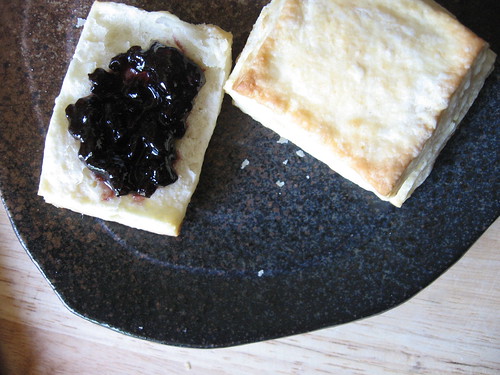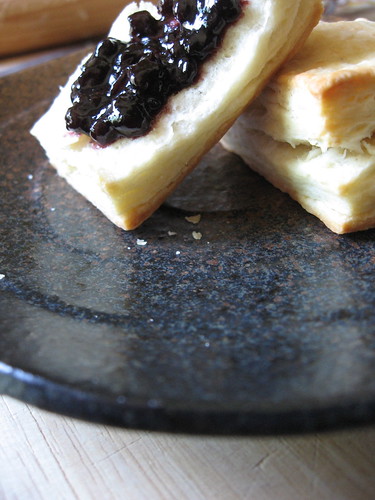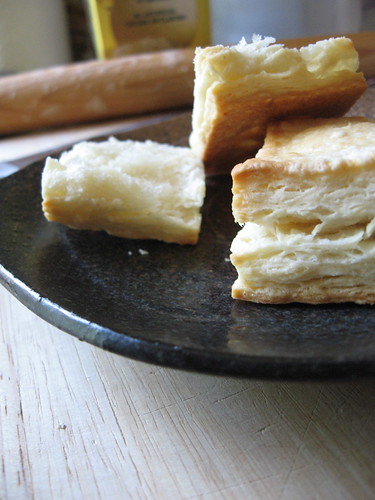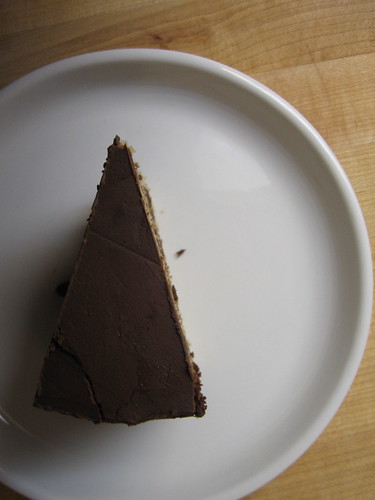
This is the time of year when all I want to make is dessert. Apple cake; banana bread; pear tart. I've had a dangerous obsession with pudding lately, and cold weather makes me develop an illogical affection for ice cream. Kale is beginning to show up again, and I made my first batch of squash soup this weekend, but
I don't think I will get truly excited about fall vegetables until I find my first early Brussels sprout.
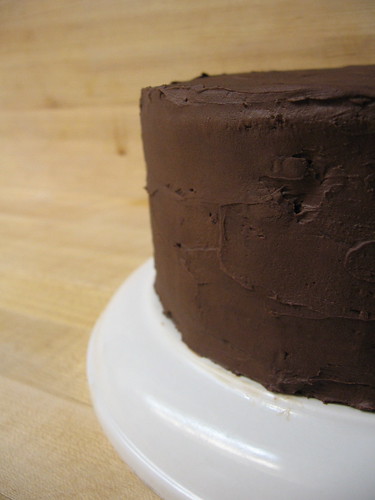
Luckily for me, my birthday was last week, so a cake was in order. I don't eat a lot of cake in the summer, as most of my fruit goes into tarts and pies, so I wanted to do something new. I was originally planning on making a rum cake for my birthday—I've been toying for years with the idea of recreating a cake from a bakery up near Mike's hometown, and I was spurred into action when I read that the place had changed hands and gone down in quality since the last time we went.
That rum cake—which, you will notice, is not pictured here—is unlike most that I've seen. Several thin layers of moist, spiced sponge cake are brushed with rum syrup and filled with rum-spiked pastry cream; the whole thing is then frosted with more of the pastry cream and topped off with a liberal amount of shaved chocolate.
Delicious in concept, but not (yet) in reality. The sponge recipe I used was a bit too dry, the pastry cream a bit too loose. I'm
not one to be bothered by fiddling with a recipe a dozen times before I'm satisfied with it, but I couldn't accept a substandard birthday cake. After flipping through my cookbooks and browsing dozens of websites, I found myself torn between
two recipes from Smitten Kitchen. I wavered for a while, flipping back and forth between the pages on my computer, before I chose the Espresso Cake. The deciding factor? I already had everything I needed.
Never mind the fact that almond paste found its way into the house when shopping the other day ... another cake may be in my future, after all.
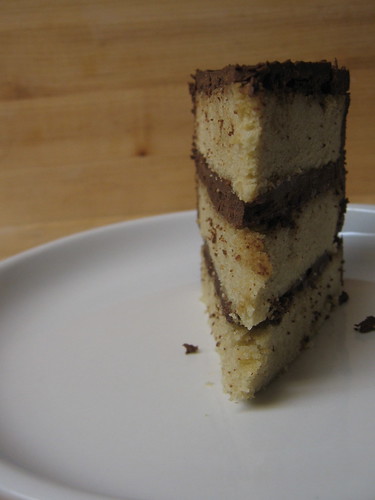
This cake is a bit time-consuming, but simple. The chiffon cake layers are assertively coffee-flavored; and a hit of espresso-rum syrup keeps them moist and adds another hit of flavor). I did decide to change the frosting—Deb calls for an instant fudge buttercream, and while "instant" and "buttercream" sound lovely together for this Swiss buttercream dévotée, it sounded too sweet and rich for my tastes. I chose instead to go with a whipped ganache—
anything with a full pound of Valrhona chocolate can't be very bad—however, ganache sets firmly and takes a long time to soften, making it a bit too difficult to slice and eat a delicate cake (you can see in the picture below where the ganache cracked when I sliced it straight out of the fridge). After all, who wants to wait an hour after slicing a cake to let the frosting soften? I made this the day before I cut into it, but it would be best to make it in the morning or early afternoon and keep it at room temperature until you're ready to serve it.
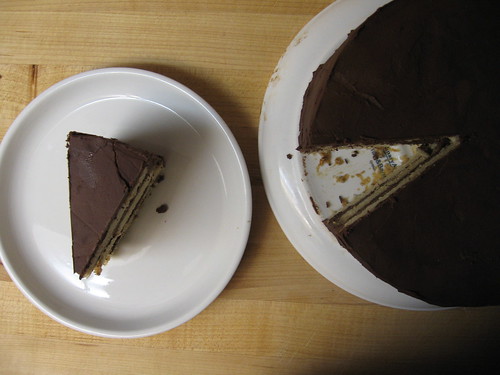 Espresso Chiffon Layer Cake
Espresso Chiffon Layer Cake
Adapted from
Smitten Kitchen (danger—you will spend far too much time drooling over/making delicious food if you click over there)
Note that because chiffon cakes owe much of their leavening to egg whites, they will collapse somewhat when cooling. This is normal; however, when you are getting ready to put the cake together, I recommend gently squeezing the base of the cake if the top of your cake shrank in very much; this will help avoid having an uneven layer of frosting on the outside of the cake. Also, know that eggs are easier to separate when cold, but whip much more easily at room temperature; I generally separate my eggs before I even start assembling the other ingredients and washing whatever dishes I need that I accidentally dirtied an hour before...
For the cakes:
¼ cup mild vegetable oil (for baking, I use canola)
6 large eggs, separated
6 tablespoons espresso, room temperature
2 teaspoons vanilla extract
5 ounces cake flour (about 1⅓ cups)
9 ounces granulated sugar, divided (about 1⅓ cups)
1 teaspoon baking powder
½ teaspoon cinnamon
½ teaspoon salt
½ teaspoon cream of tartar
For the syrup:
¼ cup hot espresso
¼ cup sugar
¼ cup dark rum
For the ganache:
1 pound bittersweet chocolate, chopped (I almost always use Valrhona Extra Bitter 61% for things like this)
1 cup heavy cream
2 tablespoons light corn syrup
3 ounces unsalted butter, room temperature (6 tablespoons)
Preheat the oven to 350ºF; make sure racks are at top and bottom thirds of the oven. Line three ungreased 8-inch round cake pans with parchment rounds and set aside.
Combine the oil, egg yolks, espresso, and vanilla in a medium bowl and whisk to combine; set aside. In a large bowl, sift together the flour, 7 ounces (1 cup) of the sugar, baking powder, cinnamon, and salt—or, if you're like me and hate sifting, whisk the mixture vigorously, which as far as I can tell does the exact same thing unless you have lumpy leavening or sugar. Set aside.
In another large bowl, combine the egg whites with the cream of tartar. Beat on low speed until foamy, then increase speed to medium-high and slowly add the remaining 2 ounces (⅓ cup) sugar. Beat until soft peaks form (if you lift the beater out of the whites, they should form a little mountain in the bowl, but with a soft tip that folds over on itself); do not beat to stiff peaks or you will end up with a dense cake.
Add the egg mixture to the flour mixture and fold together until combined. Add about a quarter of the whites and fold together quickly to lighten the mixture, then fold in the remaining whites, just until the color is uniform.
Pour the batter evenly into the prepared cake pans. Bake 17-20 minutes, swapping oven location halfway through, until they are springy to the touch and don't leave any batter on a cake tester. Transfer to cooling racks and let cool completely in the pans (30 minutes minimum).
Meanwhile, make the syrup. Measure the sugar into a small bowl, then pour the hot coffee over and stir until the sugar is dissolved. Add the rum, stir well, and let cool.
To make the ganache, heat the cream and corn syrup over medium-low heat until quite hot but not boiling. Add the chocolate and let sit 1-2 minutes, then stir until melted and smooth. Let cool until it's about the consistency of yoghurt or mayo. Beat the butter in a large bowl until fluffy, then add the cooled ganache and beat until lightened and stiff, about 3-5 minutes (you don't want to overbeat it; three minutes may not be enough with a hand mixer, but it certainly should be with a stand mixer).
To assemble the cake, run a knife around the edge of each cake and invert onto the racks; remove the parchment paper. Place the first layer, bottom side up, on the cake platter. Brush with one third of the espresso syrup, then carefully spread with just over a cup of the frosting; after being soaked in syrup, the cake will be fragile, so be gentle. Repeat with the remaining layers, frosting the sides of the cake with the remaining frosting.
Serve at room temperature; if keeping for more than a day, store in the refrigerator
Serves at least 12; you could probably feed 16 easily after a big meal (if you want to share)
 This is the time of year when all I want to make is dessert. Apple cake; banana bread; pear tart. I've had a dangerous obsession with pudding lately, and cold weather makes me develop an illogical affection for ice cream. Kale is beginning to show up again, and I made my first batch of squash soup this weekend, but I don't think I will get truly excited about fall vegetables until I find my first early Brussels sprout.
This is the time of year when all I want to make is dessert. Apple cake; banana bread; pear tart. I've had a dangerous obsession with pudding lately, and cold weather makes me develop an illogical affection for ice cream. Kale is beginning to show up again, and I made my first batch of squash soup this weekend, but I don't think I will get truly excited about fall vegetables until I find my first early Brussels sprout.
 Luckily for me, my birthday was last week, so a cake was in order. I don't eat a lot of cake in the summer, as most of my fruit goes into tarts and pies, so I wanted to do something new. I was originally planning on making a rum cake for my birthday—I've been toying for years with the idea of recreating a cake from a bakery up near Mike's hometown, and I was spurred into action when I read that the place had changed hands and gone down in quality since the last time we went.
That rum cake—which, you will notice, is not pictured here—is unlike most that I've seen. Several thin layers of moist, spiced sponge cake are brushed with rum syrup and filled with rum-spiked pastry cream; the whole thing is then frosted with more of the pastry cream and topped off with a liberal amount of shaved chocolate.
Delicious in concept, but not (yet) in reality. The sponge recipe I used was a bit too dry, the pastry cream a bit too loose. I'm not one to be bothered by fiddling with a recipe a dozen times before I'm satisfied with it, but I couldn't accept a substandard birthday cake. After flipping through my cookbooks and browsing dozens of websites, I found myself torn between two recipes from Smitten Kitchen. I wavered for a while, flipping back and forth between the pages on my computer, before I chose the Espresso Cake. The deciding factor? I already had everything I needed.
Never mind the fact that almond paste found its way into the house when shopping the other day ... another cake may be in my future, after all.
Luckily for me, my birthday was last week, so a cake was in order. I don't eat a lot of cake in the summer, as most of my fruit goes into tarts and pies, so I wanted to do something new. I was originally planning on making a rum cake for my birthday—I've been toying for years with the idea of recreating a cake from a bakery up near Mike's hometown, and I was spurred into action when I read that the place had changed hands and gone down in quality since the last time we went.
That rum cake—which, you will notice, is not pictured here—is unlike most that I've seen. Several thin layers of moist, spiced sponge cake are brushed with rum syrup and filled with rum-spiked pastry cream; the whole thing is then frosted with more of the pastry cream and topped off with a liberal amount of shaved chocolate.
Delicious in concept, but not (yet) in reality. The sponge recipe I used was a bit too dry, the pastry cream a bit too loose. I'm not one to be bothered by fiddling with a recipe a dozen times before I'm satisfied with it, but I couldn't accept a substandard birthday cake. After flipping through my cookbooks and browsing dozens of websites, I found myself torn between two recipes from Smitten Kitchen. I wavered for a while, flipping back and forth between the pages on my computer, before I chose the Espresso Cake. The deciding factor? I already had everything I needed.
Never mind the fact that almond paste found its way into the house when shopping the other day ... another cake may be in my future, after all.
 This cake is a bit time-consuming, but simple. The chiffon cake layers are assertively coffee-flavored; and a hit of espresso-rum syrup keeps them moist and adds another hit of flavor). I did decide to change the frosting—Deb calls for an instant fudge buttercream, and while "instant" and "buttercream" sound lovely together for this Swiss buttercream dévotée, it sounded too sweet and rich for my tastes. I chose instead to go with a whipped ganache—anything with a full pound of Valrhona chocolate can't be very bad—however, ganache sets firmly and takes a long time to soften, making it a bit too difficult to slice and eat a delicate cake (you can see in the picture below where the ganache cracked when I sliced it straight out of the fridge). After all, who wants to wait an hour after slicing a cake to let the frosting soften? I made this the day before I cut into it, but it would be best to make it in the morning or early afternoon and keep it at room temperature until you're ready to serve it.
This cake is a bit time-consuming, but simple. The chiffon cake layers are assertively coffee-flavored; and a hit of espresso-rum syrup keeps them moist and adds another hit of flavor). I did decide to change the frosting—Deb calls for an instant fudge buttercream, and while "instant" and "buttercream" sound lovely together for this Swiss buttercream dévotée, it sounded too sweet and rich for my tastes. I chose instead to go with a whipped ganache—anything with a full pound of Valrhona chocolate can't be very bad—however, ganache sets firmly and takes a long time to soften, making it a bit too difficult to slice and eat a delicate cake (you can see in the picture below where the ganache cracked when I sliced it straight out of the fridge). After all, who wants to wait an hour after slicing a cake to let the frosting soften? I made this the day before I cut into it, but it would be best to make it in the morning or early afternoon and keep it at room temperature until you're ready to serve it.
 Espresso Chiffon Layer Cake
Adapted from Smitten Kitchen (danger—you will spend far too much time drooling over/making delicious food if you click over there)
Note that because chiffon cakes owe much of their leavening to egg whites, they will collapse somewhat when cooling. This is normal; however, when you are getting ready to put the cake together, I recommend gently squeezing the base of the cake if the top of your cake shrank in very much; this will help avoid having an uneven layer of frosting on the outside of the cake. Also, know that eggs are easier to separate when cold, but whip much more easily at room temperature; I generally separate my eggs before I even start assembling the other ingredients and washing whatever dishes I need that I accidentally dirtied an hour before...
For the cakes:
¼ cup mild vegetable oil (for baking, I use canola)
6 large eggs, separated
6 tablespoons espresso, room temperature
2 teaspoons vanilla extract
5 ounces cake flour (about 1⅓ cups)
9 ounces granulated sugar, divided (about 1⅓ cups)
1 teaspoon baking powder
½ teaspoon cinnamon
½ teaspoon salt
½ teaspoon cream of tartar
For the syrup:
¼ cup hot espresso
¼ cup sugar
¼ cup dark rum
For the ganache:
1 pound bittersweet chocolate, chopped (I almost always use Valrhona Extra Bitter 61% for things like this)
1 cup heavy cream
2 tablespoons light corn syrup
3 ounces unsalted butter, room temperature (6 tablespoons)
Preheat the oven to 350ºF; make sure racks are at top and bottom thirds of the oven. Line three ungreased 8-inch round cake pans with parchment rounds and set aside.
Combine the oil, egg yolks, espresso, and vanilla in a medium bowl and whisk to combine; set aside. In a large bowl, sift together the flour, 7 ounces (1 cup) of the sugar, baking powder, cinnamon, and salt—or, if you're like me and hate sifting, whisk the mixture vigorously, which as far as I can tell does the exact same thing unless you have lumpy leavening or sugar. Set aside.
In another large bowl, combine the egg whites with the cream of tartar. Beat on low speed until foamy, then increase speed to medium-high and slowly add the remaining 2 ounces (⅓ cup) sugar. Beat until soft peaks form (if you lift the beater out of the whites, they should form a little mountain in the bowl, but with a soft tip that folds over on itself); do not beat to stiff peaks or you will end up with a dense cake.
Add the egg mixture to the flour mixture and fold together until combined. Add about a quarter of the whites and fold together quickly to lighten the mixture, then fold in the remaining whites, just until the color is uniform.
Pour the batter evenly into the prepared cake pans. Bake 17-20 minutes, swapping oven location halfway through, until they are springy to the touch and don't leave any batter on a cake tester. Transfer to cooling racks and let cool completely in the pans (30 minutes minimum).
Meanwhile, make the syrup. Measure the sugar into a small bowl, then pour the hot coffee over and stir until the sugar is dissolved. Add the rum, stir well, and let cool.
To make the ganache, heat the cream and corn syrup over medium-low heat until quite hot but not boiling. Add the chocolate and let sit 1-2 minutes, then stir until melted and smooth. Let cool until it's about the consistency of yoghurt or mayo. Beat the butter in a large bowl until fluffy, then add the cooled ganache and beat until lightened and stiff, about 3-5 minutes (you don't want to overbeat it; three minutes may not be enough with a hand mixer, but it certainly should be with a stand mixer).
To assemble the cake, run a knife around the edge of each cake and invert onto the racks; remove the parchment paper. Place the first layer, bottom side up, on the cake platter. Brush with one third of the espresso syrup, then carefully spread with just over a cup of the frosting; after being soaked in syrup, the cake will be fragile, so be gentle. Repeat with the remaining layers, frosting the sides of the cake with the remaining frosting.
Serve at room temperature; if keeping for more than a day, store in the refrigerator
Serves at least 12; you could probably feed 16 easily after a big meal (if you want to share)
Espresso Chiffon Layer Cake
Adapted from Smitten Kitchen (danger—you will spend far too much time drooling over/making delicious food if you click over there)
Note that because chiffon cakes owe much of their leavening to egg whites, they will collapse somewhat when cooling. This is normal; however, when you are getting ready to put the cake together, I recommend gently squeezing the base of the cake if the top of your cake shrank in very much; this will help avoid having an uneven layer of frosting on the outside of the cake. Also, know that eggs are easier to separate when cold, but whip much more easily at room temperature; I generally separate my eggs before I even start assembling the other ingredients and washing whatever dishes I need that I accidentally dirtied an hour before...
For the cakes:
¼ cup mild vegetable oil (for baking, I use canola)
6 large eggs, separated
6 tablespoons espresso, room temperature
2 teaspoons vanilla extract
5 ounces cake flour (about 1⅓ cups)
9 ounces granulated sugar, divided (about 1⅓ cups)
1 teaspoon baking powder
½ teaspoon cinnamon
½ teaspoon salt
½ teaspoon cream of tartar
For the syrup:
¼ cup hot espresso
¼ cup sugar
¼ cup dark rum
For the ganache:
1 pound bittersweet chocolate, chopped (I almost always use Valrhona Extra Bitter 61% for things like this)
1 cup heavy cream
2 tablespoons light corn syrup
3 ounces unsalted butter, room temperature (6 tablespoons)
Preheat the oven to 350ºF; make sure racks are at top and bottom thirds of the oven. Line three ungreased 8-inch round cake pans with parchment rounds and set aside.
Combine the oil, egg yolks, espresso, and vanilla in a medium bowl and whisk to combine; set aside. In a large bowl, sift together the flour, 7 ounces (1 cup) of the sugar, baking powder, cinnamon, and salt—or, if you're like me and hate sifting, whisk the mixture vigorously, which as far as I can tell does the exact same thing unless you have lumpy leavening or sugar. Set aside.
In another large bowl, combine the egg whites with the cream of tartar. Beat on low speed until foamy, then increase speed to medium-high and slowly add the remaining 2 ounces (⅓ cup) sugar. Beat until soft peaks form (if you lift the beater out of the whites, they should form a little mountain in the bowl, but with a soft tip that folds over on itself); do not beat to stiff peaks or you will end up with a dense cake.
Add the egg mixture to the flour mixture and fold together until combined. Add about a quarter of the whites and fold together quickly to lighten the mixture, then fold in the remaining whites, just until the color is uniform.
Pour the batter evenly into the prepared cake pans. Bake 17-20 minutes, swapping oven location halfway through, until they are springy to the touch and don't leave any batter on a cake tester. Transfer to cooling racks and let cool completely in the pans (30 minutes minimum).
Meanwhile, make the syrup. Measure the sugar into a small bowl, then pour the hot coffee over and stir until the sugar is dissolved. Add the rum, stir well, and let cool.
To make the ganache, heat the cream and corn syrup over medium-low heat until quite hot but not boiling. Add the chocolate and let sit 1-2 minutes, then stir until melted and smooth. Let cool until it's about the consistency of yoghurt or mayo. Beat the butter in a large bowl until fluffy, then add the cooled ganache and beat until lightened and stiff, about 3-5 minutes (you don't want to overbeat it; three minutes may not be enough with a hand mixer, but it certainly should be with a stand mixer).
To assemble the cake, run a knife around the edge of each cake and invert onto the racks; remove the parchment paper. Place the first layer, bottom side up, on the cake platter. Brush with one third of the espresso syrup, then carefully spread with just over a cup of the frosting; after being soaked in syrup, the cake will be fragile, so be gentle. Repeat with the remaining layers, frosting the sides of the cake with the remaining frosting.
Serve at room temperature; if keeping for more than a day, store in the refrigerator
Serves at least 12; you could probably feed 16 easily after a big meal (if you want to share)
